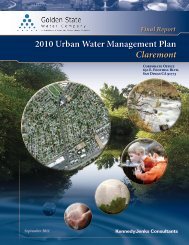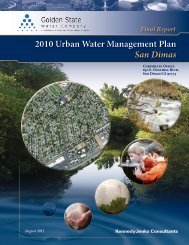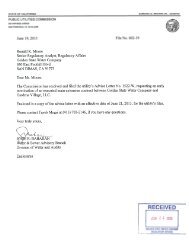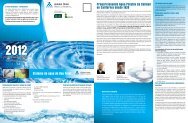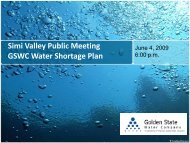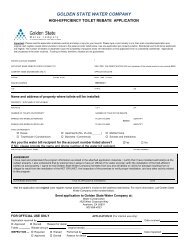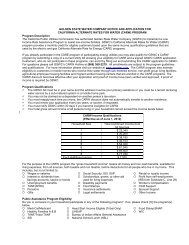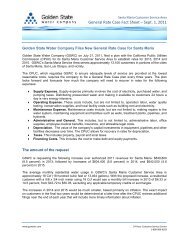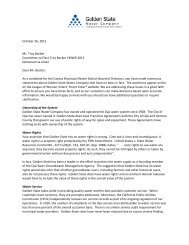Final Report, 2010 Urban Water Management Plan - Culver City
Final Report, 2010 Urban Water Management Plan - Culver City
Final Report, 2010 Urban Water Management Plan - Culver City
You also want an ePaper? Increase the reach of your titles
YUMPU automatically turns print PDFs into web optimized ePapers that Google loves.
• Use of potable water which results in flooding or runoff in gutters or streets.• Use of potable water for washing private cars or commercial aircrafts, cars, buses, boats, ortrailers, except, at a fixed location where water is properly maintained to avoid wasteful use.• Use of potable water for washing buildings, structures, driveways, street cleaning or otherhard-surfaced areas.• Use of potable water to irrigate turf, lawns, gardens or ornamental landscaping.• Use of potable water for construction purposes.• Use of potable water for filling or refilling of swimming pools.Rule No. 20 (approved in 1978) discourages wasteful use of water and promotes use of watersaving devices. The stated purpose of the rule is to “ensure that water resources available tothe utility are put to a reasonable beneficial use and that the benefits of the utility's water supplyand service extend to the largest number of persons." Together, Rules 11, 14.1 and 20 prohibitnegligent or wasteful use of water, create a process for mandatory conservation and rationing,and promote the use of water saving devices.7.3.1.3 <strong>Water</strong> Loss ControlUnaccounted for water losses are monitored by the <strong>Water</strong> Loss Control Department (WLCD) byreviewing the <strong>Water</strong> Audit program’s survey results for each system. If the amount ofunaccounted for water exceeds the established tolerance levels, a Leak Detection Audit isperformed. This is conducted by the <strong>Water</strong> Loss Control Technician with the most current leakdetection technology, a Sonic Leak Detection Sound Amplification Instrument. To pinpoint leaks,the technician conducts a comprehensive survey of the system by making physical contact withall available main line valves, hydrant valves and all service connections.For calendar year 2009, GSWC implemented the American <strong>Water</strong> Works Association (AWWA)M36 Standard <strong>Water</strong> Audit methodology. The approach consists of a component analysis ofleaks for designation into “revenue” and “non-revenue” categories and an economic analysis ofrecoverable loss. Results of the analysis, which are included in Appendix E, show aninfrastructure leakage index (ILI) of 0.22.Before the AWWA Standard <strong>Water</strong> Audit M36 methodology was implemented, prescreening forwater losses was conducted by comparing the total volume of water sales and other verifiableuses against the total water supply into the system. A full audit was triggered if the total salesand verifiable uses was less than 90 percent of the total supply (i.e., unaccounted-for-waterexceeded 10 percent). Table 7-2 summarizes prescreening results.<strong>Final</strong> <strong>Report</strong>, <strong>2010</strong> <strong>Urban</strong> <strong>Water</strong> <strong>Management</strong> <strong>Plan</strong> – <strong>Culver</strong> <strong>City</strong> Page 7-5Golden State <strong>Water</strong> Companyg:\adminasst\jobs\<strong>2010</strong>\1070001.00_gswc-uwmp\09-reports\9.09-reports\2011-08\grp3\gswc_culvercity_<strong>2010</strong>_uwmp-final.doc




